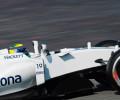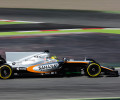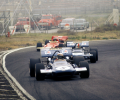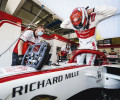AUTO #24 - The Evolving Formula
While Formula 1 is set for major revisions in 2021, the FIA and the sport’s commercial rights holder are laying the foundations for change with a new set of 2019 regulations designed to tackle one the most pressing issues – how to promote closer racing and more overtaking…

What makes for a good Formula 1 grand prix? Ask 10 people working in motor sport and you’ll get 10 different answers – but the one thing everyone agrees on is the need for close racing.
In some quarters, this is misinterpreted as shorthand for ‘ceaseless overtaking’, but close racing offers more subtlety than that: the potential for overtaking, certainly, but also a fair battle between attack and defence.
At certain circuits, the current generation of F1 cars have found close racing to be an elusive quantity. Last year’s aerodynamic reset created faster cars with greater downforce, capable of smashing lap records all around the world. But the regulations also had the unintended consequence of making it very difficult for one car to follow another. Changes to the F1 technical regulations are going to address this next year.
It’s no secret that the FIA and Formula 1 have been looking at a far-ranging technical reboot for the sport in 2021, but an opportunity arose to deliver an early taster next season. The changes for 2019 are a small subset of the bigger project. A research collaboration between the FIA and F1 produced a standalone revision that could be introduced in isolation without undue disruption. Eight of the 10 F1 teams undertook simulations earlier this year and their results unambiguously suggested the proposals would make racing closer. Accordingly, the changes were fast-tracked into the F1 technical regulations for 2019.
The problem at the heart of the matter is downforce, or lack thereof. Modern F1 cars generate vast amounts of downforce but occupy a very narrow operating window. Downforce dominates car performance, but for a car to gain the full measure from its aerodynamic package it needs to travel through undisturbed (‘clean’) air. This is the very opposite of the environment it occupies when it follows another car: the leader creates a turbulent (‘dirty’) wake, and the deeper a following car gets into that wake, the more its own aerodynamic performance suffers. The predators struggle to get close to their prey.
A certain amount of turbulence is inevitable and, indeed, is not unwelcome as it cancels out the advantages of slipstreaming, making for a good, even contest. But the aerodynamic direction taken by the current generation of cars produces a very turbulent wake as an unfortunate by-product of a faster, more efficient car. Aerodynamicists use a measure called Total Pressure Coefficient (TPC) when talking about the energy contained within an airflow. Where the leading car has a TPC equal to one, a car following closely may have a TPC as low as 0.4 or 0.5. Empirically, this means that car loses 40-50 per cent of its downforce. The new rules seek to reduce this turbulence and restore balance to the contest between attack and defence
Formula 1 Chief Technical Officer Pat Symonds, one of the experts at the heart of the project, explains the problem succinctly: “The front wheels of an F1 car produce a very dirty wake and teams naturally want to push it to the side to get nice, clean air flowing over the rest of the car. They do this by producing specific vortices with the front wings and brake ducts. If you look at the current front wings, there are a lot of appendages and elements sitting on top of the wing. Each one is designed to produce a vortex, to control that wake. Unfortunately, when you start pushing the front wheel wake out a long way, you create a very wide area of low-energy air behind the car, which reduces the downforce on the following car.”
The effect cannot be eliminated but it can be mitigated. The intention with the new regulations is to reduce the ‘outwash’ wake from the front wheels by changing the shape and nature of the front wing, and simplifying the front brake ducts. This will make the airflow follow a more natural path over and around the car. The differences in bodywork will be noticeable, but perhaps only to the sharp-eyed.
“It’s quite a heavy rule change that’s being introduced for the front wing,” says noted aerodynamicist Nikolas Tombazis, the FIA’s head of single-seater technical matters. “It will be reduced to five elements only, and we’ve put in place rules that will only allow these elements to change shape gradually and smoothly across the span without the discontinuities, extra profiles and fins on the top surface that create the strategic vortices that push the wheel wake outboard today. The end plates become much simpler and underneath the wing teams will be limited to a maximum of two fences.”
Behind the front wing, the new regulations will also simplify the front brake ducts. Over the last few years brake ducts have become fantastical flights of fancy, convoluted into sculpted crenellations, the purpose of which has little to do with cooling the brakes and a great deal to do with generating more vortices and channelling air out and away through hollow wheel hubs. The new rules will simplify the ducts, stripping them of the vortex-shedding winglets in use today.
The mushroom effect
Keeping the wake closer to the centreline of the car isn’t simply an exercise in narrowing the field of turbulence: the significance is, by keeping the turbulent air close inboard, it stays in the zone where it will be collected by the rear wing and thrust upward and, it is to be hoped, over the following car in a phenomenon aerodynamicists refer to as ‘mushrooming’.
“The rear wing helps us when we’re trying to promote closer racing,” explains Tombazis. “It has two strong trailing vortices, which pull the flow up from close to the ground into the ‘mushroom’. This mushroom is pushed upwards quite violently and quickly, allowing clean air to be pulled in from the sides to take the place of the turbulent air being flung upwards. This clean air tends to be higher energy, which has a beneficial effect on the aerodynamics of the following car.
“We want to increase that mushroom effect and make it stronger, but also put more of the dirty air into its vicinity to push it up and out of the way.”
While the changes to the front of the car would have a significant effect in isolation, the new rules, as Tombazis suggests, give a further boost by making the rear wing more powerful. It will become 50mm wider, 20mm deeper and hopefully will help create a stronger upwash.
How big an improvement will this make? There is a clamour for numbers but forecasting the real-world performance for cars half a year and more away from launch is an exercise that is more art than science. The teams that chose to simulate the new geometry all agree it delivers results that should be a boon for closer racing, though by how much is a question that won’t properly be answered until next season gets underway – although some teams started testing their 2019 wings at the in-season test conducted after July’s Hungarian Grand Prix.
Williams was one of those teams and Chief Technical Officer Paddy Lowe professes himself a fan of the new regulations. Lowe, while working at McLaren, was a member of the Overtaking Working Group that was responsible for the aerodynamic revamp in 2009, the last time F1 created geometry specifically to allow cars to get closer.
“It’s well known that Williams supported this set of regulations,” he says. “Having understood a lot of the history and been involved in the past with developing regulations for better car following, I’ve appreciated the work that’s been done recently.
“I was not a fan of the 2017 regulations which,
I thought, were a backwards step for overtaking. I feel that not doing anything now would mean we’d have several years of a worsening situation as the teams develop more downforce. The FIA and FOM were correct to act at this point and do something different for 2019 and 2020. I’ve got quite a high confidence in the technical aspects of what’s been done, that it will take us back in the right direction.”
It’s hard to put numbers on how much of a difference the new geometry will generate, not least because every car has a unique level of sensitivity to the wake and thus will be affected differently by its reduction. When asked to gauge the potential effects, Tombazis suggests any numbers are little more than educated guesses at this stage, but he
is prepared to outline the potential.
“We consider the critical position to be around 15 to 20 metres between the cars. That’s the distance we’d expect to see between cars running half a second apart approaching a medium-speed corner. With the current generation, the following car loses about 30 per cent of its downforce in this scenario. We hope to reduce that by 10 per cent.
“It’s difficult to provide an exact number. What I would say is that there is a general trend for teams to develop more downforce, which would exacerbate the problem. If we had not intervened, we feel that 2019 would be worse than 2018, and 2020 would be worse than 2019. We now believe that 2019 will be better than 2018, but no one is expecting F1 cars to be fighting like touring cars.”
Part of F1’s allure is the eclectic demands of different circuits and the challenge of designing cars that can perform across a wide range of conditions, from the wide-open high-speed blast of Silverstone to the needle-threading intricacies of Monaco. Recent years have produced races with record levels of overtaking, but also others where the leader board has a tendency towards the static. The aim of these rule changes isn’t to turn the calendar into a homogenous festival of overtaking akin to that seen on oval tracks, but rather to provide the edge-of-the-seat drama that closer racing automatically gives.
This may lead to more overtaking, but equally it may highlight the grit and determination required for a great defensive drive. These are both desirable outcomes: the FIA and the F1 community desire a technical package that allows drivers to use every gram of their experience, courage and skill – and be rewarded for it. The more comprehensive changes planned for 2021 are expected to have a more dramatic effect, but 2019’s tweaks are a promising step in the right direction. On this there is a clear consensus.
Click here to read AUTO Magazine #24

 Facebook
Facebook Twitter
Twitter






